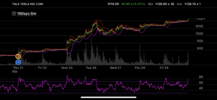bballshinobi
Member
One thing I thought about is how a lot of consolidation happens around January and February. Typically in January and February, there is tax selling. Those that made a lot of money in 2021 often wait until 2022 to cash in so they won't have to pay taxes on their gains until 2023. That likely contributed to the downward movement after the last peak when it got into the S&P-500. With a possible rewriting of how much people are taxed in upcoming legislation, there may be people willing to sell before these tax laws are enacted.
A lot of great news coming from November-December (Austin and Berlin, etc.) and COVID cases/deaths going down in the US. I could see it staying high for a while. That will contribute to market euphoria.
TSLA is such a big deal now that it really moves the NASDAQ-100. You can see how TSLA moves intraday usually show up in QQQ a few minutes later. I sometimes invest in TQQQ along with TSLA so like to watch both tickers.
I think we are already in a bit of euphoria right now lol. Ok, maybe not the market in general, but Tesla for sure. Everybody in the main investor thread is celebrating. Twitter people are saying TSLA will go to $2,500 in 6 months. WSB are buying calls. Even CNBC was pumping us. I guess I am just the type of player that likes to play in a hostile away game more than a cheering home game lol.




